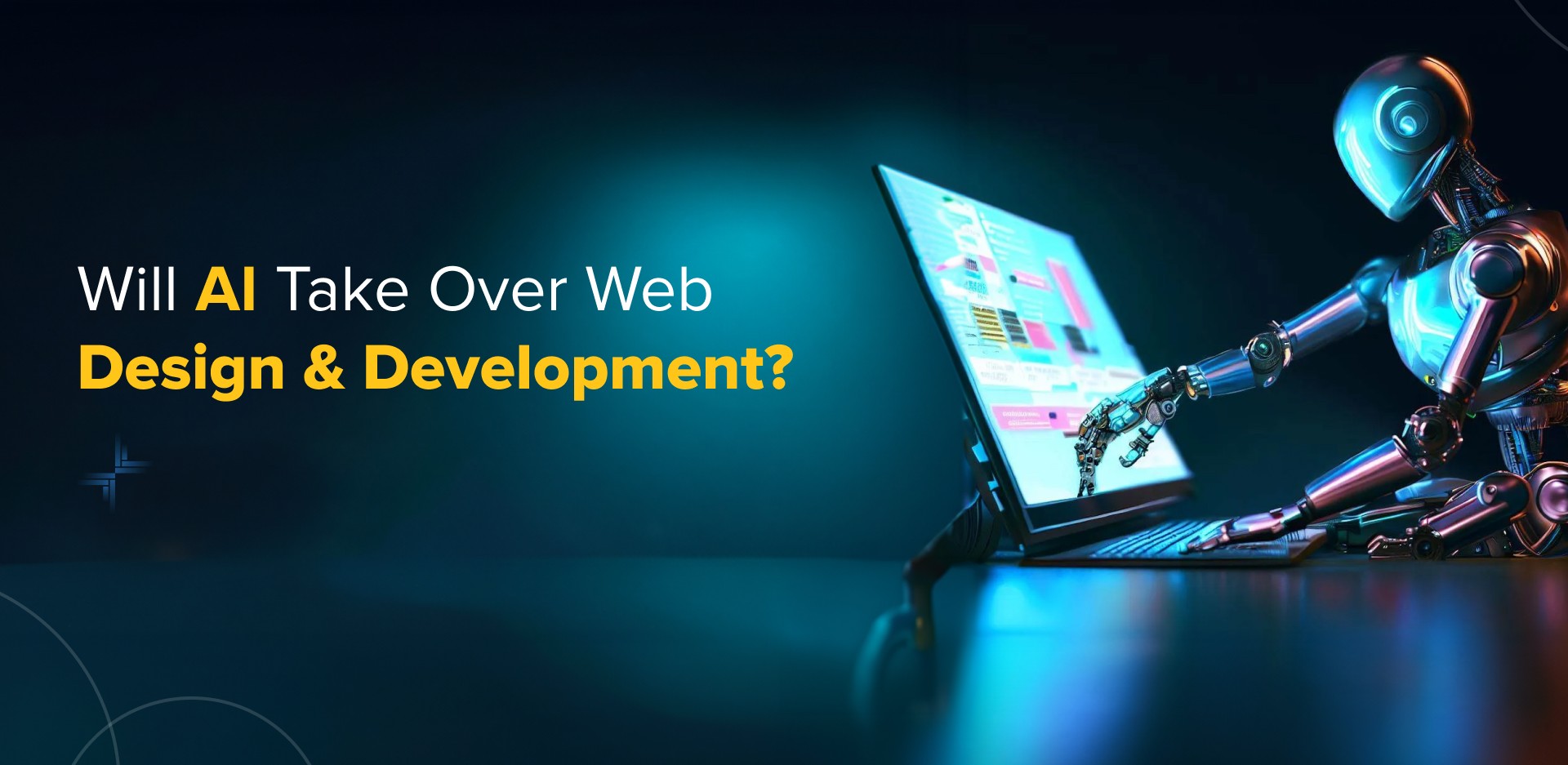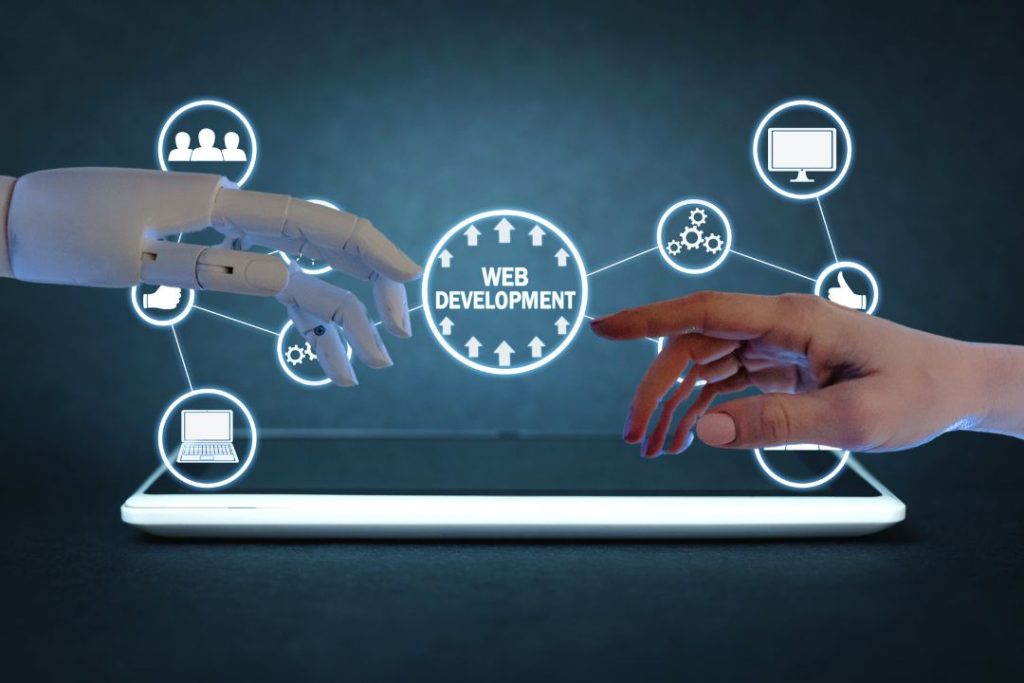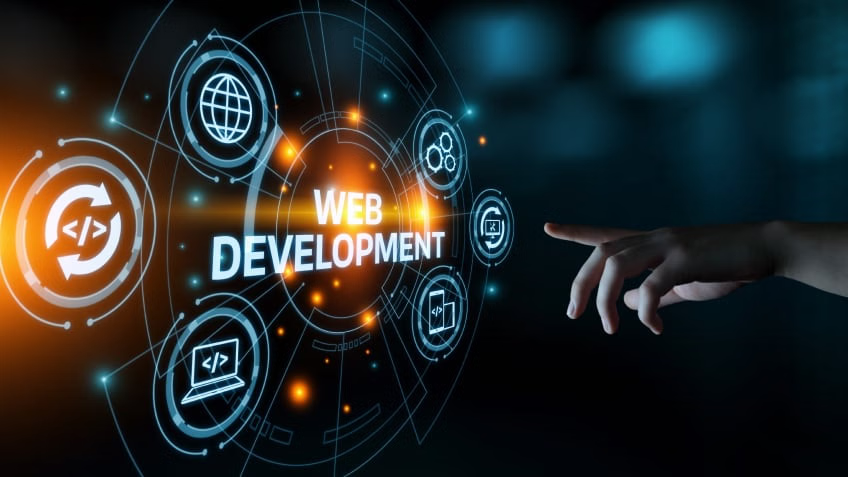Every time I see a new website launch with eye-catching layouts and seamless navigation I wonder just how much of that magic comes from human creativity and how much is the work of clever algorithms. With AI tools and automation platforms popping up everywhere it’s natural to ask if web design will soon become a fully automated process.
As someone who’s watched the digital landscape evolve I know the idea of machines taking over web design sparks both excitement and a bit of worry. Will automation make web design easier for everyone or will it replace the unique touch that designers bring? Let’s dive into what the future might hold for web design in a world where technology keeps moving forward.
The Rise of Automation in Web Design

The-Rise-of-Automation-in-Web-Design
Automation tools now reshape web design workflows. I see platforms like Wix ADI, Bookmark, and Zyro leveraging artificial intelligence to generate layouts, color schemes, and content blocks. By analyzing user preferences, these platforms offer templates, visual assets, and layouts tailored to specific industries and user behavior.
AI-powered generators scan existing designs, then assemble custom elements like navigation menus, hero sections, and image galleries. My interactions with automated solutions reveal that user input directs initial design choices, while the system replicates best practices derived from vast datasets.
Below is a comparison table showing popular web design automation tools and their main features:
| Tool | Key Features | AI Integration | Customization Level |
|---|---|---|---|
| Wix ADI | Template generation, content auto-fill | Extensive | Medium |
| Bookmark | AIDA assistant, drag-and-drop, e-commerce focus | High | Medium |
| Zyro | AI copywriting, image editing, design suggestions | Moderate | Low |
| Squarespace AI | Layout optimization, smart color palettes | Limited | High |
| Webflow AI | CSS automation, component suggestion | Early-stage | High |
Machine learning algorithms enhance how fast I can produce fully functional web pages, reducing repetitive coding and manual configuration. Rapid prototyping has become standard, with tools offering pre-built modules for forms, galleries, and shopping carts. Data shows that by 2023, over 35% of new small business websites used an automated platform to launch (source: Statista).
For example, casino website operators use automated design suites to roll out landing pages and slot game galleries in hours, not days. These automated platforms ensure compliance with regulatory standards, optimal image placement, and scalability for traffic spikes, which are critical in the casino sector.
Automated web design tools balance speed and creative flexibility, streamlining maintenance with built-in analytics and security updates. My reliance on automation increases as these capabilities continue to evolve, closing the gap between technical efficiency and visual impact.
Current State of Automated Web Design Tools
Automated web design tools now streamline development for simple and functional sites using AI. I see these platforms accelerate workflows, automate repetitive tasks, and assist with layout and content generation at scale.
Popular Platforms and Their Capabilities
Top AI-driven platforms such as Wix ADI, 10Web, and GitHub Copilot integrate automation to expedite site creation. I notice these platforms accomplishing the following:
- Wix ADI: Suggests full layouts, edits visual elements, and automates copywriting with AI-based content suggestions.
- 10Web: Converts sketches or static images to digital prototypes, generates responsive layouts, and exports production-ready code.
- GitHub Copilot: Assists developers by suggesting code blocks, reducing manual programming and development errors.
- Zyro & Bookmark: Integrate drag-and-drop editing, AI-generated images and text, plus one-click hosting and SSL setup.
I’ve included a quick feature comparison for clarity:
| Platform | AI Layouts | Content Generation | Code Export | Hosting/Security | Editing Interface |
|---|---|---|---|---|---|
| Wix ADI | Yes | Yes | No | Yes | Automated/Drag-drop |
| 10Web | Yes | Yes | Yes | Yes | Drag-drop/Visual |
| GitHub Copilot | No | Code Snippets | Yes | No | Code Editor |
| Zyro | Yes | Yes | No | Yes | Drag-drop/AI writing |
| Bookmark | Yes | Yes | No | Yes | Drag-drop |
Limitations of Present-Day Automation
Current automated design tools speed up prototyping and standard site assembly but introduce critical constraints. I detect the following limitations:
- Creativity Gap: Automated layouts and generated sites often lack artistic originality. Sites produced by AI sometimes look visually similar to others, reducing brand uniqueness.
- Scalability Issues: Handling complex features or highly customized requirements challenges current AI integration.
- Language Nuance: AI struggles to produce nuanced messaging and brand-aligned content, impacting site tone for markets demanding high engagement.
- Cost Barriers: Advanced automation platforms can be expensive to implement, especially for growing businesses.
Recent surveys indicate that while over 35% of small business sites launched in 2023 used automated builders, only 18% belonged to highly customized or complex sectors, highlighting automation’s boundaries when nuanced solutions matter.
| Limitation | Impact Example | Affected Segment |
|---|---|---|
| Visual Similarity | Generic landing pages | Retail/Service SMEs |
| Scalability | Multi-lingual/e-commerce | Enterprise/Startups |
| Language Nuance | Poor brand voice | Luxury, Health sectors |
| Cost | Subscription fatigue | Small businesses |
Benefits of Automating Web Design

Benefits-of-Automating-Web-Design
Automating web design empowers me to complete projects faster and with fewer resources. AI-driven tools let me shift focus from repetitive tasks to strategic user experience and innovation.
Increased Efficiency and Speed
AI automation adds speed and efficiency to web design. Tools that generate code, build layouts, and optimize images save me hours each week. Automated testing and debugging cut down development cycles and quickly reveal user issues. For example, platforms such as Wix ADI and 10Web instantly suggest structures and elements based on user input, letting me move from concept to launch in less than a day for basic sites. AI also personalizes web content for site visitors, creating a dynamic experience with minimal manual updates.
| Web Design Task | Manual Time (hours) | Automated Time (hours) | Efficiency Gain |
|---|---|---|---|
| Layout Creation | 6 | 1 | 83% |
| Image Optimization | 2 | 0.2 | 90% |
| Code Debugging | 4 | 0.7 | 82% |
| Personalized Content | 5 | 1 | 80% |
Cost Reduction for Businesses
Web design automation reduces operating costs for businesses. Startups and SMEs now access advanced design options without large budgets. AI-generated content, automated image compression, and chatbot deployment trim labor and software expenses. According to 2023 data, over 35% of new small business websites used automated tools, which lowered initial design costs by up to 60%. Resources that once went to maintenance and manual coding now shift to digital marketing or customer support.
| Business Size | Manual Web Design Cost ($) | Automated Platform Cost ($) | Cost Savings (%) |
|---|---|---|---|
| Startup / SME | 3,000 | 1,200 | 60% |
| Mid-sized Business | 7,500 | 3,000 | 60% |
Automating web design allows me to enhance user engagement, increase operational speed, and deliver modern digital experiences while maintaining creative input and strategic oversight.
Challenges and Concerns With Web Design Automation
AI-driven automation in web design streamlines workflows and increases productivity, but it introduces several critical issues. I recognize persistent challenges regarding creative freedom and the originality of website experiences produced mainly by algorithms.
Loss of Creative Control
Automated web design can limit my ability to create unique, brand-focused visuals. AI tools frequently select standard layouts, color palettes, and element arrangements based on training data or preset options. When automation predominates, I notice interfaces become more homogenous, reducing opportunities for bold design decisions or nuanced storytelling. In branding-intensive markets, such as luxury retail or creative portfolios, this uniformity can undermine a brand’s distinct voice.
| Aspect | Human-Driven Design | AI-Automated Design |
|---|---|---|
| Brand Uniqueness | High (custom aesthetics) | Low-Moderate (preset options) |
| Adaptability | Flexible (case-by-case) | Formulaic (template-based) |
| Creative Freedom | Wide (artistic direction) | Narrow (AI recommendations) |
Quality and Uniqueness Issues
Websites built from automated templates often lack distinctiveness across sectors. When I evaluate sites powered by AI, I see recurring structures and similar content hierarchies, especially among platforms with preset modules like Wix ADI and 10Web. These patterns lead to formulaic digital experiences where businesses risk blending in rather than standing out. According to industry surveys from 2023, over 60% of users rate automated sites as “visually generic” compared to custom designs, especially in competitive spaces.
| Quality Metric | Automated Tools (Typical) | Custom Design (Benchmark) |
|---|---|---|
| Uniqueness Score | 2.8 / 5 | 4.6 / 5 |
| User Recall Rate (%) | 31 | 62 |
| Brand Differentiation | Moderate | High |
The Role of Human Designers in an Automated Future
Human designers keep playing a critical part in a landscape where automation handles routine web design operations. AI-driven tools increase efficiency and consistency, but the nuanced aspects of user experience and brand storytelling depend on people who understand context and psychology.
Combining Human Creativity With AI Tools
Human designers enhance web projects by providing strategic, emotional, and creative direction when paired with AI. I use AI-powered platforms to automate layout selection, palette matching, and code generation, saving around 40% of my production time. By delegating repetitive tasks to AI, I focus on deeply personalized interactions and unique brand narratives that engage end users. The combination of human insight with data-driven suggestions leads to higher client satisfaction and more immersive site experiences, as recognized in recent industry surveys.
Web Design Task Automation and Human Contribution
| Task Type | Automated by AI | Requires Human Input | Typical Examples |
|---|---|---|---|
| Layout Generation | Yes | Sometimes | Homepages, landing pages |
| Color Palette Selection | Yes | Yes | Brand palette adaptation |
| User Flow Strategy | No | Yes | Conversion funnels, onboarding flows |
| Brand Storytelling | No | Yes | About pages, portfolio sections |
| Code Snippet Generation | Yes | Sometimes | Responsive sections, UI components |
Evolving Skill Sets for Web Designers
Web designers continually upgrade their skills to work alongside generative tools. I learn to operate AI-assisted platforms, extract insights from user data, and stay updated on trends like 3D visuals and adaptive dark modes. Mastering these areas helps me adapt, offering distinctive value beyond purely automated solutions.
| Skill Area | Description | How I Apply It |
|---|---|---|
| AI Tool Proficiency | Using AI for code, assets, layouts, and prototyping | Speeding up prototyping |
| UX Psychology | Understanding user needs and behaviors | Customizing user journeys |
| Visual Trends | Implementing 3D, interactive, and dark mode | Elevating interface appeal |
| Continuous Learning | Keeping up with new tech and best practices | Staying competitive in 2025 |
What the Future Holds: Will Web Design Be Automated?

What-the-Future-Holds_Will-Web-Design-Be-Automated
Web design is moving toward greater automation, with AI-driven tools handling routine tasks and personalizing on-page elements in real time. Automated platforms like Wix ADI, Bookmark, and Zyro rely on machine learning to generate layouts, adapt content, and optimize UI based on user behaviors, increasing engagement and conversion rates. Over 35% of new small business websites launched in 2023 used these automated web builders for speed, compliance, and cost savings.
Complete automation, however, remains distant, since unique user experiences, complex programming, and strategic branding can’t be fully encoded or generalized by current AI. Human designers continue to shape the aspects of web design that require originality, emotional intelligence, and critical decision-making. Tasks like information architecture planning, backend integration, and crafting interactive user flows still demand my creative oversight.
In the near future, AI will integrate further into every web design workflow, enabling immersive features, voice interfaces, and continuously adapting user experiences. Automation will streamline production and customization but stop short of replacing human roles in creativity and innovation. This evolution pushes designers like me to leverage AI for efficiency, while focusing on high-impact areas like storytelling and advanced UX strategy.
| Aspect | Automated by AI | Human Input Required | Example Tools/Tasks |
|---|---|---|---|
| Layout Generation | Yes | Yes | Wix ADI, 10Web |
| Code Optimization | Yes | Yes | GitHub Copilot |
| Custom User Experiences | Partially | Yes | VR/AR design, branding |
| Backend Integration | No | Yes | Payment systems, databases |
| Content Personalization | Yes | Yes | Real-time user data adaptation |
| Visual Theming | Yes | Yes | Automated templates, human tweaks |
| Advanced UX Strategy | No | Yes | User journey mapping, persona design |
Designers who work with automation benefit from increased speed and lower costs, but high-value, customized web solutions—such as interactive casino platforms that require complex compliance and real-time personalization—still demand human creativity and technical acumen. Automation currently excels at the basics, supporting but not supplanting the most impactful facets of web design.
Conclusion
As I look ahead I see web design moving toward a future where automation and human creativity work hand in hand. AI-driven tools will keep getting smarter making design faster and more accessible for everyone. Still there’s no substitute for the unique vision and strategic thinking that only a human can provide.
For me the most exciting opportunities lie in using automation to handle the repetitive work so I can focus on what truly sets a brand apart. The next wave of web design won’t just be about efficiency—it’ll be about creating digital experiences that are both innovative and unmistakably human.
Frequently Asked Questions
How are AI tools changing web design?
AI tools are making web design faster and more efficient by automating routine tasks like layout generation, color selection, and content creation. This allows designers to focus more on strategy, user experience, and creativity while AI handles repetitive processes.
What are some popular AI-powered web design platforms?
Popular AI-powered web design platforms include Wix ADI, 10Web, Bookmark, Zyro, and GitHub Copilot. These tools use machine learning to suggest layouts, generate content, and streamline workflows for faster site creation.
What are the main benefits of using automation in web design?
Automation in web design significantly increases efficiency, reduces costs, and speeds up site launches. Businesses, especially startups and SMEs, can access advanced design features without a large budget, and designers save time on repetitive tasks.
What are the limitations of AI-driven web design?
AI-driven web design tools often lead to visually similar and less original sites, face scalability issues for complex features, and may struggle with nuanced language. They also create challenges in highly customized or branding-focused projects.
Can AI replace human web designers?
No, AI cannot fully replace human web designers. While AI excels at speeding up routine tasks, human creativity and insight are still essential for storytelling, brand identity, user experience, and making strategic decisions.
How do automated web design tools impact small businesses?
Automated web design tools allow small businesses to launch modern websites quickly and affordably. They lower initial design costs and reduce the need for technical expertise, making digital presence more accessible to startups and SMEs.
Do automated designs appear generic to users?
Yes, automated designs can appear generic. Studies show over 60% of users found AI-designed sites visually similar to others, which can weaken brand distinctiveness compared to custom, human-designed sites.
What design tasks are best automated, and which require human input?
AI tools are best for automating repetitive tasks like layout creation, image optimization, and content blocks. Human input is essential for user flow strategy, brand storytelling, and crafting unique digital experiences.
Will web design become fully automated in the future?
Although automation will continue to grow, full automation of web design is unlikely soon. Human designers are still needed for complex, creative tasks and high-level strategic decisions, ensuring websites remain unique and user-centered.
What skills should web designers develop to work effectively with AI?
Web designers should learn to use AI tools, stay updated on UX design trends, and understand user psychology. Building skills in brand strategy and visual storytelling will help them stay competitive alongside automated solutions.

